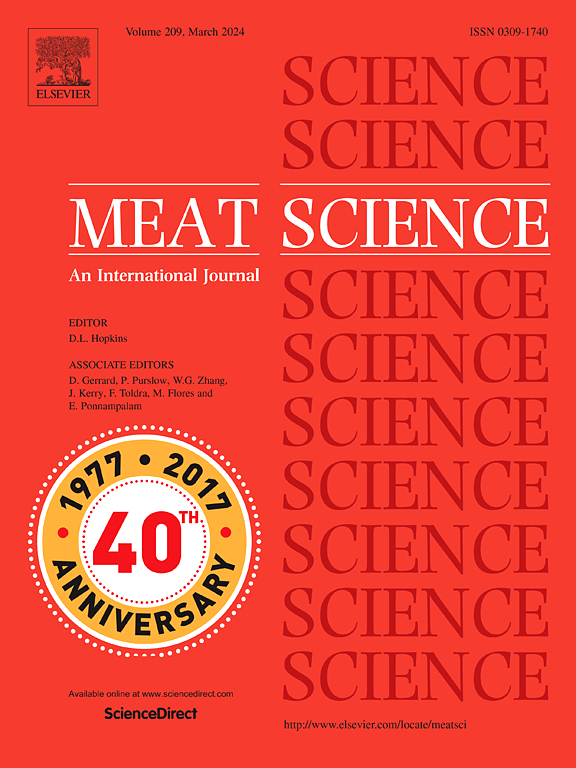Analysis of relationship between pork belly preference and fat level by distributors in the Korean pork market: Utilizing belly cross-sectional assessment and belly fat percentage measured by VCS2000
IF 7.1
1区 农林科学
Q1 Agricultural and Biological Sciences
引用次数: 0
Abstract
This study aimed to determine the relationship between the overall fat percentage of pork belly and the visual fat level of pork belly, and to determine whether these factors influence the distributor's preference. Fat percentages in LYD pigs' pork bellies were measured using VCS2000, and visual fat levels were assessed through cross-sectional photographs. Additionally, a survey was conducted across four distributor types (direct managed stores, supermarkets, National Agricultural Cooperative Federations (NACFs), and butcher shops) to understand distributor preferences in the pork market.
The results demonstrated a moderate correlation between pork belly fat percentage and appearance-based belly fat level. The regression equations between distributors' pork belly preferences and pork belly fat percentage showed that all regression equations exhibited coefficient of determination (R2) values below 0.2, indicating that pork belly fat percentage could not be explained by distributors' pork belly preferences. The regression equations between appearance-based belly fat level and distributors' pork belly preferences demonstrated that all regression equations exhibited an R2 value of 0.75 or higher, indicating that appearance-based belly fat level can effectively explain distributors' pork belly preferences. Furthermore, it was observed that there were variations in distributors' preferences contingent on the appearance-based belly fat level.
Appearance-based belly fat level was found to be reliable indicators for predicting pork belly preferences. The findings of this study are expected to assist in the reduction of unnecessary distribution costs when planning the delivery of pork belly.
分析韩国猪肉市场经销商对猪肚的偏好与脂肪水平之间的关系:利用腹部横断面评估和 VCS2000 测量的腹部脂肪百分比。
本研究旨在确定猪肚整体脂肪百分比与猪肚视觉脂肪水平之间的关系,并确定这些因素是否会影响经销商的偏好。使用 VCS2000 测量了涟源猪猪肚的脂肪百分比,并通过横截面照片评估了视觉脂肪水平。此外,还对四种类型的经销商(直营店、超市、全国农业合作联盟(NACF)和肉店)进行了调查,以了解猪肉市场上经销商的偏好。结果表明,猪肚脂肪百分比与基于外观的猪肚脂肪水平之间存在适度的相关性。分销商的猪肚偏好与猪肚脂肪百分比之间的回归方程显示,所有回归方程的决定系数(R2)值均低于 0.2,表明猪肚脂肪百分比无法用分销商的猪肚偏好来解释。基于外观的猪肚脂肪含量与分销商猪肚偏好之间的回归方程显示,所有回归方程的 R2 值均在 0.75 或以上,表明基于外观的猪肚脂肪含量能有效解释分销商的猪肚偏好。此外,研究还发现,分销商的偏好因外表腹部脂肪水平的不同而存在差异。研究发现,基于外观的腹部脂肪水平是预测猪肚偏好的可靠指标。预计本研究的结果将有助于在计划猪肚配送时减少不必要的配送成本。
本文章由计算机程序翻译,如有差异,请以英文原文为准。
求助全文
约1分钟内获得全文
求助全文
来源期刊

Meat Science
工程技术-食品科技
CiteScore
12.60
自引率
9.90%
发文量
282
审稿时长
60 days
期刊介绍:
The aim of Meat Science is to serve as a suitable platform for the dissemination of interdisciplinary and international knowledge on all factors influencing the properties of meat. While the journal primarily focuses on the flesh of mammals, contributions related to poultry will be considered if they enhance the overall understanding of the relationship between muscle nature and meat quality post mortem. Additionally, papers on large birds (e.g., emus, ostriches) as well as wild-captured mammals and crocodiles will be welcomed.
 求助内容:
求助内容: 应助结果提醒方式:
应助结果提醒方式:


